Q&A: Margaret Wertheim
By:
January 18, 2010
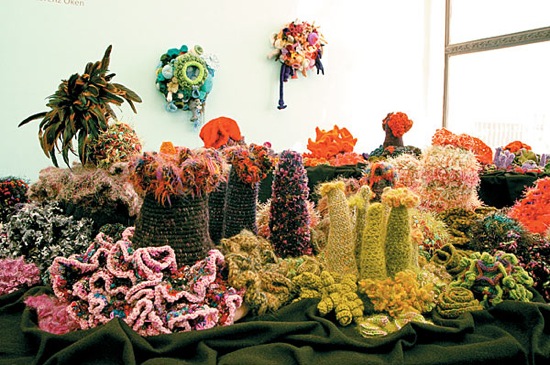
Margaret Wertheim is an Australian-born science writer who — along with her sister, the poet and critic Christine Wertheim — cofounded the Institute for Figuring, a Los Angeles-based organization “dedicated to the poetic and aesthetic dimensions of science, mathematics and the technical arts.” In 2005, the Wertheims launched the Hyperbolic Crochet Coral Reef Project in their Highland Park living room; in 2010, the now-massive sculpture will be exhibited at the Smithsonian. From the beginning, the Wertheims imagined the project as a collective enterprise — but they had no idea how far it would spread. HiLobrow.com’s Joshua Glenn interviewed Margaret Wertheim in January 2010, as background for the Indirect Collaboration panel he’ll moderate at this year’s SXSW.
GLENN: What is the Hyperbolic Crochet Coral Reef Project?
WERTHEIM: We produce sculptures that are a crocheted version of the Great Barrier Reef. Coral reefs have this very distinctive look about them — these crenellated, frilly forms, which are basically versions of hyperbolic geometry. And it turns out that the only way we know how to make models of hyperbolic geometry is with crochet. [From the IFF website: “The basic insight is to understand that these forms result from the simple process of increasing the number of stitches in every row. The more often you increase stitches the faster the model will grow and the more crenellated the finished form will become.”] The Project was conceived because coral reefs all over the world are dying out. The evidence is that by 2030, corals might not grow any more due to the effect of carbon dioxide in the atmosphere going into the seas. So the Project resides at the intersection of mathematics, marine biology, feminine handicraft, and collective art practice. It is also a political project, because it is raising consciousness of global warming.
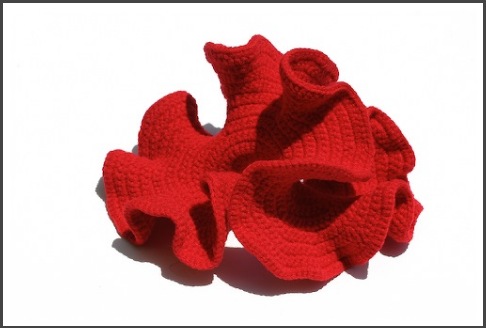
GLENN: The code that allows you to model hyperbolic geometry with crochet was discovered by Daina Taimina, a Latvian mathematician at Cornell. Was it she who figured out that these crochet models look like bits of coral reef?
WERTHEIM: Dr. Taimina was interested in just doing them as pure mathematical models. Christine and I realized, after we’d crocheted a few [hyperbolic models], that if you started deviating from the mathematical perfection of Taimina’s models, the [resulting creations] actually looked like a coral reef. As soon as we started varying the formulae a little, you get things that are not mathematically perfect — so, not good for teaching a course on hyperbolic geometry at Cornell, but they look a lot more organic. We realized, this is what nature is doing. Nature is not being strictly geometrically perfect because nature doesn’t have to adhere to the rules of mathematics. Instead, it is doing variations, and that is why you get the diversity of forms in nature — because life starts from a simple code and then diversifies and complexifies. We started saying, “OK, how can we replicate things that look like natural forms rather than pure mathematical ones?”
GLENN: How has the Crochet Reef developed differently, thanks to “indirect collaboration,” to use Joe Alterio and Tim Lillis’s phrase, than it otherwise might have?
WERTHEIM: Everybody who takes up these [crochet] techniques starts to vary it in different ways — in ways that that we would never have thought of, necessarily, ourselves. So you get this endless variation that comes from people just trying things that are, as it were, inherent in the whole system. [From the IFF site: “Loopy ‘kelps,’ fringed ‘anemones,’ and curlicued ‘corals’ have all been modeled. While the process that brings these models into being is algorithmic, endless permutations of the underlying formulae result in a constantly surprising panoply of shapes. The quality of yarn, style of stitch, and tightness of the crochet all affect the finished forms so that each is as individual as a living organism.] Which raises very beautiful questions about the relationship between pure mathematics and the physically manifest material structure of the world that we actually live in.
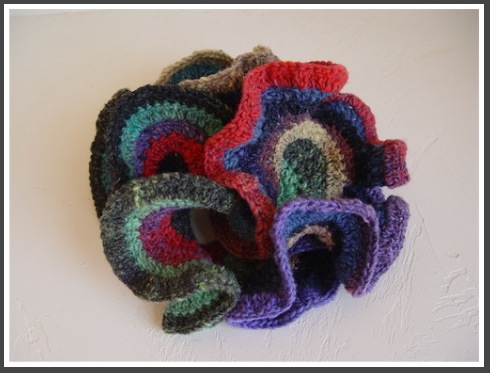
GLENN: You and your sister started to make the Crochet Reef in Christmas 2005. Did you imagine it as an open-source collaborative project from the beginning?
WERTHEIM: Yes, I put up an announcement on the Institute for Figuring website asking for people to join us. We thought maybe ten, twenty people around the world would join us — and that the final project would occupy a few coffee tables’ worth of space. Nearly five years later, there have been thousands of people who have contributed models to our exhibitions and hundreds of thousands of people have come to the exhibitions, and who knows how many have attended workshops and learned to do it. It has become this unintended worldwide movement, and it has just blown our minds.
GLENN: Why has the Crochet Reef, which has no major institutional support of any kind and very little funding, taken off like this?
WERTHEIM: What people are really doing when they participate in the Project is a form of experimental mathematics. And I think it is not insignificant that that is happening among women, not men. We have had a few men, and we welcome them, but 99.99% of people who do this are women — who tell us, again and again, that they love the idea of being taken seriously as people who engage with math and science. Here is a project in the context of a handicraft that women feel comfortable with and enjoy, and they are being told, “You too, can understand the mathematics that underlies general relativity.” The Project has tapped into a hunger of women, everywhere, to be taken seriously as intellectual forces. Which is a reason that I’ve made it my full-time job, though there is no full-time salary.
GLENN: Might the Crochet Reef one day receive funding from the kinds of institutions that try to engage folks with scientific and mathematical ideas — through things like Lego Mindstorms and the X Prize?
WERTHEIM: I guarantee, from my work as a science communicator, that 99% of people who engage in Lego Mindstorms will be boys. Millions of dollars are being pumped into such projects, and there is no money being pumped into the Crochet Coral Reef Project, which is engaging thousands and thousands of women and girls all over the world. I think community projects and community creativity, it is one of the important trends of our time. But the resources available to encourage such projects are overwhelmingly in computers, say, or robotics. I am all for those things, but most of people involved in those things are boys. Engaging people in math and science can also take place in things like paper and scissors, it can take place in crochet. There are lots of handicrafts that have math and science involved — in fact, weaving led to the invention of the loom, and punch-cards come from the loom, and punch-cards helped lead to the computer. So it can be argued that weaving was the first digital technology. When any collective project happens, it’s worth asking a political question: “Where is the support, and which projects get supported?”
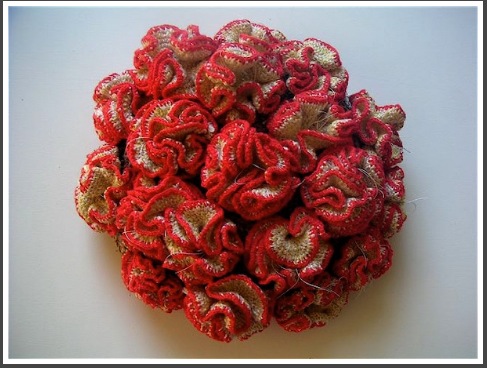
GLENN: Is the opportunity to collaborate in a collective artwork — as opposed to being a solo artist — another important part of the appeal of the Crochet Reef?
WERTHEIM: One thing that we get told, again and again, is how much engagement with the math and science is meaningful. And the other thing that the participants tell us that is immensely powerful to them is the opportunity to participate in a total work that is more than just themselves. In the upper echelons of the art world, what is valorized is the individual genius of the artist. But what this project taps into is the opposite of that. There are many tens of thousands of hours of work in this totality. When you walk into an art exhibition where there is more than five hundred people’s work on display, the sheer congealed hours of human labor helps you see that it is just simply is physically impossible for one person to do this much work. The totality of what thousands of people produced is much more — both greater and more beautiful — than what any individual genius, one individual person, could produce.
GLENN: So it’s not merely the Crochet Reef’s sheer size that’s so impressive, but its variation?
WERTHEIM: When you walk into a room with five hundred people’s work and each person has been free to express themselves differently — obviously many of them just do the “canonical” reef patterns, but lots of them will also take up and go in special directions — you get such a feeling of commitment and intensity, of handmade labor. There are knitting machines, but there is no such thing as a crochet machine, so the Project is true commitment.
GLENN: Do you think women are more attracted to collaborative projects than men are?
WERTHEIM: In terms of the collective group enterprise, women have been having sewing circles and quilting bees since the dawn of time. Some critics have argued, with good cause, that the collective feminist art projects of the early 1970s — like the 1972 installation “Womanhouse” — were the start of this whole trend that is now called Relational Aesthetics, which is to say artistic practices that take as their point of departure human relations as opposed to a solo genius, and which has been taken up by many men.
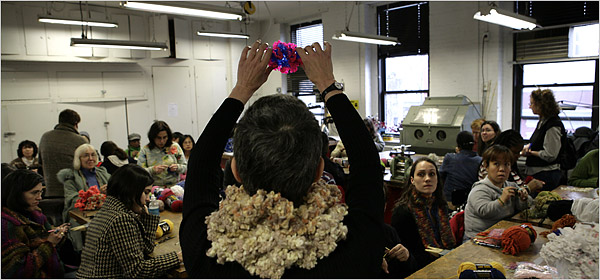
GLENN: What is your end goal for the Crochet Reef?
WERTHEIM: What we would love is if some museum somewhere would give it a permanent home so we could set it up once and for all beautifully. It is too big to store in our house. At the moment it is all in storage in Arizona, and then it will go to Ireland, and then to Smithsonian Museum of Natural History later this year.
GLENN: If a museum does take the Crochet Reef, will people stop contributing to it?
WERTHEIM: I doubt it. Every week, I get emails from communities all over the world saying, “We want to do this.” It has truly gone viral. People say, “How long do you intend to keep doing this?” I don’t know. I used to have a serious career as a science journalist. I write books about the cultural history of physics, and I have been struggling to get my most recent book finished because the reef literally took over my life.
READ MORE essays by Joshua Glenn, originally published in: THE BAFFLER | BOSTON GLOBE IDEAS | BRAINIAC | CABINET | FEED | HERMENAUT | HILOBROW | HILOBROW: GENERATIONS | HILOBROW: RADIUM AGE SCIENCE FICTION | HILOBROW: SHOCKING BLOCKING | THE IDLER | IO9 | N+1 | NEW YORK TIMES BOOK REVIEW | SEMIONAUT | SLATE
Joshua Glenn’s books include UNBORED: THE ESSENTIAL FIELD GUIDE TO SERIOUS FUN (with Elizabeth Foy Larsen); and SIGNIFICANT OBJECTS: 100 EXTRAORDINARY STORIES ABOUT ORDINARY THINGS (with Rob Walker).
